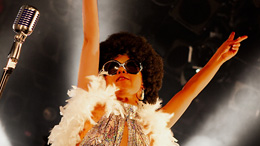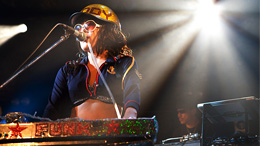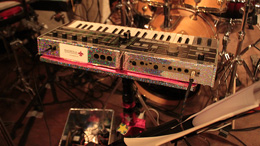Debuted as a soul singer
Up until college, my main area of studies were piano and vocal performances in classical music. But I was especially fond of rhythm music. When I finished college, I immediately searched for soul and funk bands, and joined gospel and chorus groups. Eventually, I got to know James Brown Tribute, led by Serjiho Muto, which got my foot in the door.

My band members and I used to watch YouTube videos of the magnificent Roger Troutman and discussed how awesome it would be to be able to perform like him. We soon developed interest in call & response, and with the fact that there are such few female talkboxers. That's how we decided to incorporate the talkbox into our performances.
Female talkboxers
There were tons of YouTube videos describing the mechanism of the talkbox, so I thought I had a good idea. But when I actually played it, I was blown away by the huge pressure of sound coming through the tube connected to the Rocktron Banshee. It was as if I were a speaker and the sound resonated through my entire body. I had never experienced anything like it before, so it took a while for me to get used to the whole process. Then, friends and acquaintances asked whether or not I get headaches from playing the talkbox. It worried me a bit, so I researched a bit on the Internet and found out that there are no cases of talkboxers developing any funny symptoms. Whew.

At first, I had difficulty with the pronunciation of the consonants. I also immediately realized that there were distinct differences between male and female talkboxers, even when we were using the exact same instruments. I think female talkboxers have higher frequency levels and clearer sound compared to male talkboxers. Talkboxers vibrate their vocal cords and use their whole body to resonate the sound, so it is only natural every talkboxer to sound unique. Which means, it was impossible for me to completely copy Roger's sound. Yes, I debuted on Roger's death date, yes, I covered ZAPP's tunes saying I was the female-version-Roger, but my obsession has slowly calmed down since the release of my first solo album. I am focusing more on Woddy Funk's sound ever since.
|
|
1823M
Offers for gigs lined up non-stop before my techniques were on par with other professional talkboxers. I learned what it takes to become a talkboxer on stage. I reviewed my recordings and constantly practiced until I was good enough. Most of the people in my audience were long time soul/funk fans, and they were blunt as to what sounded good or bad that day. Also, Roger was a born-to-be performer, and every movement on stage had a meaning. And that's how I learned to not look at the keys, and to keep my head up and eyes towards the audience at all times.

My first talkbox was a combination of a Rocktron Banshee and a Korg microKORG, but I wasn't happy with the noise on the Rocktron Banshee. Bad pronunciation combined with noise, was bad in every aspect. However, a guy from the audience recommended me the Electro Voice 1823M. He even had an Electro Voice 1823M, himself, with Roger's autograph. My first impression of the 1823M was an obvious cut back in noise but with more sound pressure and range. It was an eye-opening experience, because the Rocktron Banshee never had enough power to shine when the other instruments in the band played around it. The 1823M is still my main gear until today.
Talkbox system:
- Keyboard: Yamaha DX27, KORG microKORG
- Talkbox: Electro Voice 1823M, GF WORKS Tubeholder
- Power amp: Crate Power Block
Using different gears for different purposes
I decide on the gear depending on the tune and whether if it's a recording or a live gig. For example, the sparkly sound in "YA-SA-SHI-KU" is created by a YAMAHA DX27 and an Electro-Harmonix 44Magnum, and a KORG microKORG and a Crate Power Block were used for the bridge, just to make a distinction. Because my talkbox sound is fairly high, I typically use a warm-sounding Yamaha DX27 for recordings. On the other hand, a solid and portable KORG microKORG is used for live performances. I used to take a compact and powerful Electro-Harmonix 44Magnum to gigs, but ever since the band members told me that it sounded like I was singing instead of talkboxing, I switched back to the Crate Power Block.
|
|
|


